Home
A comprehensive resource for safe and responsible laser use
US: Probation and fine for "bored" man who aimed laser pointer at helicopter during Milwaukee protests
The laser strikes occurred seven times between May 31 and June 7 2021 in the summer of 2020 during protests in Milwaukee. An FBI surveillance airplane and a Wisconsin National Guard helicopter were targeted. The FBI crew began wearing anti-laser goggles to protect against bright laser light. A camera on board their aircraft was used to determine the laser's location. Ground officers then went in and arrested 39-year-old Jeremiah Belen, a resident of Milwaukee.

Jeremiah Belen
Belen apologized to the judge during his sentencing. He said he had the laser for astronomy pointing with his two children. He aimed at the aircraft because he was bored after being laid off during the COVID pandemic.
Prosecutors said they wanted the felony conviction to "send a message" that aiming at aircraft, especially during civil unrest, is dangerous.
Belen could have received up to five years in prison for his action, but was given probation due to no previous criminal history and having found a job since his arrest.
From 715 Newsroom, and the Milwaukee Journal Sentinel via MSN
US: FBI offers $2,500 reward for arrest of person aiming a laser at an Air Force aircraft
The aircraft was on approach to Savannah Air National Guard Base when it was "deliberately struck by a high-powered laser for about one minute" according to the FBI. A crew member had temporary eye damage from the laser strike.
Anyone with information about the March 9 laser strike is asked to contact FBI Atlanta at 770-216-3000 or go to tips. fbi.gov.
From Military.com,The Advance, and the Associated Press
US: Navy says China aimed invisible "military-grade" laser at Navy aircraft
A U.S. Navy P-8A Poseidon maritime patrol aircraft was lased by People’s Republic of China (PRC) navy destroyer 161 on Feb. 17 while flying in airspace above international waters approximately 380 miles west of Guam.
The P-8A was operating in international airspace in accordance with international rules and regulations. The PRC navy destroyer’s actions were unsafe and unprofessional.
Additionally, these acts violate the Code for Unplanned Encounters at Sea (CUES), a multilateral agreement reached at the 2014 Western Pacific Naval Symposium to reduce the chance of an incident at sea. CUES specifically addresses the use of lasers that could cause harm to personnel or damage to equipment. The destroyer’s actions were also inconsistent with a Memorandum of Understanding (MOU) between U.S. Department of Defense and the Ministry of National Defense of the PRC regarding rules of behavior for safety of air and maritime encounters.
The laser, which was not visible to the naked eye, was captured by a sensor onboard the P-8A. Weapons-grade lasers could potentially cause serious harm to aircrew and mariners, as well as ship and aircraft systems.
The P-8A is assigned to VP-45, based out of Jacksonville, Florida, and is forward-deployed to Kadena Air Force Base in Okinawa, Japan. The squadron conducts routine operations, maritime patrol and reconnaissance in the U.S. 7th Fleet area of operations.
U.S Navy aircraft routinely fly in the Philippine Sea and have done so for many years. U.S. Navy aircraft and ships will continue to fly, sail and operate anywhere international law allows.
U.S. 7th Fleet is the largest numbered fleet in the world, and with the help of 35 other maritime-nation allies and partners, the U.S. Navy has operated in the Indo-Pacific region for more than a century, providing credible, ready forces to help preserve peace and prevent conflict.
Thanks to Greg Makhov for bringing this to our attention.
UPDATE February 28 2020: The day after the above press release, the U.S. Navy posted a photo on its Instagram account showing an island and an inset rave light show.
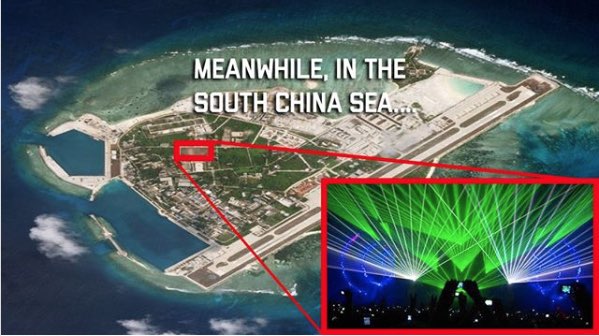
The text of the Navy's post read:
"#ICYMI [in case you missed it] The Chinese Navy recently pointed a laser in an unsafe and unprofessional manner at a #USNavy P-8A flying in airspace above international waters. These acts violate the Code for Unplanned Encounters at Sea, a multilateral agreement reached at the 2014 Western Pacific Naval Symposium to reduce the chance of an incident at sea."
The laser aimed at the P-8A aircraft was from a destroyer, not an island. The beams were not visible to human eyes and of course, they were not from a laser light show.
From The Drive. Thank you to Leon McLin for bringing this update to our attention.
UK: Pilot said to have laser burn in eye
According to the Oxford Mail, "the extent of his injury is unknown at this time [Feb. 19], although it is expected he will make a full recovery and return to training."
The next night, another training aircraft was hit by a laser in the same general area. No injury was reported.
An investigating Thames Valley Police officer said "The trainee pilot of the first aircraft suffered injuries to the back of his eye as a result of this attack and the injuries may result in him being unable to fulfill a career in aviation. The recklessness of such acts not only endangers the aircraft and all passengers on board, but also those on the ground, as attacks such as this seriously jeopardize safety."
Police were asking anyone with information to contact them.
From the Oxford Mail
UPDATE: According to a February 25 2020 article in the Evening Standard, "Due to the nature of the injuries he is currently unable to fly." The article also described an incident where a green laser was aimed at an RAF C-17 cargo plane near RAF Brize Norton in Oxfordshire, on February 22 2020. This is roughly the same area as where the two training flights were illuminated on February 4 and 5.
Canada: RCAF helicopter lasered by tanker in East China Sea
According to the Regina's captain, the aircrew had been wearing protective safety lenses "just in case."
The exact date of the incident was not reported but came sometime in mid- to late June 2019.
A report by the Canadian Global Affairs Institute said the laser came from a tanker, and that "there was no obvious link between alleged attacks [to U.S. aircraft in the South China Sea and near Djibouti] and the laser that was aimed at Canada's surveillance helicopter."
A CBC News article a day earlier said Canadian military "reported that someone on board a Chinese fishing boat pointed a laser at a Canadian CH-148 Cyclone helicopter operating near the Strait of Taiwan recently. No one was injured in that incident and there no was damage to the aircraft. It is unclear whether fishing vessel was part of the People's Armed Forces Maritime Militia, which operates a host of civilian vessels in both the East China Sea and the South China Sea."
It is not known if these were two separate incidents, or if there was a single laser incident with some confusion over whether the source was a tanker or a fishing boat.
From the Canadian Global Affairs Institute via The Maritime Executive, and CBC News
Canada: Military plane on taxiway is hit by laser, aborts takeoff
The Royal Canadian Mounted Police searched for, but did not find, a suspect.
From Global News
US & Middle East (including Syria, Iraq, Afghanistan): U.S. military pilots illuminated by lasers
A spokesperson for U.S. Central Command told the paper that while the source is “exceedingly difficult to pinpoint … many likely come from insurgents and terrorist organizations.”
U.S. crews had no permanent injuries although minor effects such as short-term vision impairment and headaches were reported.
The Journal article did not indicate whether the laser illuminations were being coordinated, or if the perpetrators were using lasers of a different type or power than those commonly involved in illuminations of civilian aircraft outside of conflict zones.
Lasing rate comparison
For comparison with civil aviation, during the same January-July 2018 period American civilian pilots reported 3,182 laser illuminations to the Federal Aviation Administration. In Canada there were roughly 190 laser illuminations reported to Transport Canada, and in the U.K. there were roughly 500 laser illuminations reported to the Civil Aviation Authority.
The Middle East incidents appear to indicate a higher rate of lasing than two recent areas of concern recently disclosed by U.S. military:
- In May 2018, a Pentagon spokesperson reported “between 2 and ten” lasers aimed at U.S. aircraft operating out of Camp Lemonnier in Djibouti.
- From September 2017 to mid-June 2018, about two dozen aircraft in the East China Sea were illuminated by “smaller, commercial grade” laser pointers similar to those sold for pointing and playing with pets.
Laser incidents in the Middle East had been at about 700 in 2015, about 600 in 2016, and were at about 400 in 2017. At the current rate of about 50 per month in the first seven months of 2018, there would be about 600 incidents estimated for all of 2018.
From a Wall Street Journal article by reporter Gordon Lubold; the article is behind a paywall. A non-paywall (free) summary is at The Hill.
Click to read more...
US & East China Sea: US officials say lasers have targeted military pilots in the East China Sea
U.S. officials said the low-level, harassing beams came from fishing vessels and from shore.
U.S. and Chinese military interests have had disputes in the East China Sea in recent years. However, there was no specific indication of whether there was malicious intent, or any organized effort behind the laser incidents. The officials speculated that the lasers could be directed by the Chinese government, or could be “disgruntled Chinese fishermen… who simply want to harass American pilots.”

A spokesperson for the U.S. Indo-Pacific Command said that flying procedures have not changed due to the laser incidents. She did say pilots are “employing” required laser eye protection.
A spokesperson for the Chinese Foreign Ministry called claims that China was responsible for the East China Sea lasers “groundless and sheer fabrications.”
According to news.com.au, “All aspects of the Chinese economy are state-controlled. And its fishing fleets are operated as a militia, working in close concert with Beijing’s navy as it seeks to assert its arbitrary claim to total control of the South and East China Seas…. The waterway is, however, part of a busy sea lane carrying enormous quantities of international trade.”
Disclosure of the East China Sea incidents came about seven weeks after the United States publicly accused China of deliberately aiming lasers between two and ten times at military aircraft in Djibouti, in East Africa. In those incidents, the Pentagon said “military-grade” lasers were used. Two U.S. Air Force pilots received minor, unspecified injuries with no long-term effects.
From the Wall Street Journal, news.com.au and Stars and Stripes
Commentary from LaserPointerSafety.com: About 24 laser/aircraft incidents over nine months from boats or the shore of the East China Sea seems like a plausible number for random, unconnected civilian misuse of commonly available laser pointers.
Consider that the East China Sea has an area of about 500,000,000 square miles. This is roughly equivalent to the combined area of Texas, California and Florida. (Of course the Sea is far less populated even considering seacoast populations.)
In the U.S. in 2017, there were roughly 5,600 reported incidents over nine months, so 24 incidents in the same period is a reasonable number for a less-populated area. Another indication that these may be from civilian misuse is that U.S. officials indicated the East China Sea incidents occurred from “smaller, commercial-grade” lasers which includes readily available low-powered consumer laser pointers.
However, if Chinese fishing fleets are a “militia” as claimed by one news source, then there may be some coordination or central control for the laser attacks.
For a contrary view, see the June 25 2018 column “China is Trying to Bring Down American Planes With Lasers. Time to Get Tough” in the Daily Beast. Author Gordon Chang considers but rejects the unorganized attack hypothesis. He says “it is difficult to believe that Chinese fishermen can pick out American military aircraft from civilian ones without radar or other help. Moreover, state support is the best explanation for the increasing sophistication of the laserings.”
Chang argues that “Washington should consider the attacks, almost certainly directed by Beijing, as attempts to injure pilots and their crews. The American response, therefore, should be immediate in timing and devastating in effect….”
Bosnia: US helicopters hit four times by lasers; caused eye injuries
Intro: The pilot and a crewman on an American helicopter were hurt recently (October 24 1998) when someone fired a laser at their aircraft patrolling over Bosnia-Herzegovina. The men were able to land safely but this, and similar incidents in the Balkans, have sparked concern among U.S. air crews. U.S. military officials and police in Bosnia are investigating the incidents, and the U.S. Army says it is now changing the way it uses its helicopters. VOA's Jim Randle reports from the Pentagon.
Text: Pentagon officials say U.S. helicopters have been hit by lasers four times in Bosnia. Officials say one case caused 'mild to moderate' eye injuries when the laser light stayed on the aircraft for four or five seconds. The pilot and a sergeant were both treated for eye injuries, and both are expected to recover and be able to resume flying.
Nevertheless, Pentagon officials say the Army is changing the way It uses helicopters over Bosnia to lessen the danger to pilots -- but will give few details.
Pentagon spokesman Mike Doubleday did say pilots now have some protection from the laser threat: "What we've done to deal with the situation is to provide helicopter crews with either special glasses or goggles that protect their eyes in these situations."
An expert in weapons technology says the pilots have good reason for concern. John Pike studies strategic issues for the Federation of American Scientists. He says four thousand Iranian soldiers suffered eye injuries, including blindness, when Iraqi forces swept powerful lasers across their ranks during the Iran-Iraq War.
Mr. Pike said, "It was a lot easier for them to injure those soldiers using a laser than it was to kill them by hitting them with a bullet. And the thing is that an injured soldier is a lot more of a burden to a military than a dead soldier is, because every injured soldier requires several more to get him back to the hospital."
Mr. Pike says the Iranian battlefield lasers were those used by tanks to determine the range to a target. Other lasers are used to guide bombs and shells to targets with great precision.
Lasers are used by many nations, including the United States, in tanks, anti-aircraft weapons and to disrupt electronic devices.
Mr. Pike says recent treaties [the Protocol on Blinding Laser Weapons, a 1995 amendment to the 1980 Geneva Convention on Certain Conventional Weapons] labeled weapons specifically designed to blind soldiers as "inhumane" and banned their use. But he says with so many lasers playing so many battlefield roles, it will be difficult to enforce the ban on these weapons.
From the Federation of American Scientists
China: Pentagon made "groundless accusations" about Djibouti lasers
According to China Daily, “The Defense Ministry said in a statement that the ministry has dismissed such ungrounded accusations from some US officials via official channels. It added that China always firmly honors international laws and regulations in Djibouti, and is dedicated to safeguarding regional security and peace.”
Separately, Reuters reported that “Chinese Foreign Ministry spokeswoman Hua Chunying said the government had conducted ‘serious checks’ and told the U.S. side the accusations were groundless. ‘You can remind the relevant U.S. person to keep in mind the truthfulness of what they say, and to not swiftly speculate or make accusations,’ she told a daily briefing in Beijing.”
From China Daily and Reuters
US & Djibouti: UPDATED - Pentagon says Chinese have aimed lasers at US planes in Djibouti, causing two injuries
Spokesperson Dana White said the reason for the laser activity is unknown, “but it’s serious, we take it seriously.” She said it was “a true threat to our airmen”. The U.S. has protested and has asked the Chinese government to investigate.
Another Pentagon spokesperson, Major Sheryll Klinke, said the C-130 pilots were hit with a “military grade” laser.
On April 14 2018, the US military posted this notice to airmen (NOTAM) on the Federal Aviation Administration website, warning about “unauthorized laser activity” in Djibouti.

The NOTAM was scheduled to expire on June 14.
The NOTAM coordinates (N1135.70 E04303.14) are about 2,400 feet from China’s military base in Djibouti, opened August 1 2017 near Camp Lemonnier.
An article in the quasi-official South China Morning Post referred to “Chinese military observers [who] said the lasers might have been used to scare off birds near the airfield or disrupt possible spy drones, rather than targeting foreign pilots. A Beijing-based military analyst said China has already demonstrated laser weapons being used against drones, at airshows.
China is a signatory to the Protocol on Blinding Laser Weapons, which bans the use of lasers that cause permanent blindness. The protocol does not ban laser dazzlers, which temporarily impair vision but do not cause eye damage. It is also permitted under the Protocol to use lasers to disrupt or damage cameras and sensors such as those on missiles or satellites.
According to The Drive, “As of 2015, Chinese forces had access to at least four different man-portable systems, the BBQ-905, PY131A, PY132A, and the WJG-2002, all of which look like oversized assault rifles or shoulder-fired grenade launchers.”
From The Drive, Janes 360, C4ISRNET, Defense News, South China Morning Post, FAA PilotWeb, and a YouTube video of the May 3 2018 Pentagon press briefing by Dana White. Thanks to Greg Makhov for bringing this to our attention.
UPDATED May 4 2018: China’s Defense Ministry and Foreign Ministry both denied the U.S. allegations of laser use by China.
UPDATED May 7 2019: An annual report to Congress on Chinese military and security developments does not mention the April 2018 Djibouti laser incidents. It does mention "a few provocative Chinese military actions" but not the alleged Chinese lasers in Djibouti. A news story says the omission is "an apparent bid to preserve the controversial military exchange program with Beijing." From the Washington Free Beacon
US: UPDATED - Man takes his own life before being sentenced for aiming laser at helicopter
On February 19 2009, Joshua Don Park allegedly pointed a green laser beam two times at the Apache helicopter as it was flying over the Bluffdale area, about 20 miles south of Salt Lake City. Pilot Ken Samson said “It was strong enough that it illuminated my window, but not the entire cabin.” According to Samson, the laser was brighter than a laser pen, but was not a “military grade” laser.
The air crew notified the Salt Lake County Sheriff’s Office of the approximate location. A deputy went door to door. When they encountered Park, the 30-year-old said he had a laser pointer to play with his cats. Park admitted that he had shined a laser at the aircraft.
According to the Sheriff’s Office, Park “believed that the helicopter was way too far away for it to make an impact or even see [sic]”
Park was charged on March 11 2009 with one count of interference with the operation of an aircraft. He faces a maximum of 20 years in prison and up to a $250,000 fine.
From KSL.com (Feb 25 arrest report, March 11 charge) and Deseret News
UPDATED - August 31 2017: A National Guard pilot told the South Valley Journal that Park committed suicide shortly before he could be sentenced. Park died September 17 2009, according to a September 20 obituary in the Deseret News which included this photo:

The South Valley Journal article implied that Park’s suicide was linked to the laser incident, and that it changed how the National Guard reacted to laser incidents. The article stated “Since that sobering incident, no Utah National Guard pilots have reported lasing incidents to the FBI—but not for lack of occurrences.”
US: Military says Soviet ship aimed laser at US aircraft; injuring pilot's eyes
The incident happened September 30 or October 1, 1987. According to an October 2 1987 Pentagon statement, a U.S. Navy P-3 reconnaissance aircraft was “illuminated by an intense light” from the Soviet ship Chukotka. An Air Force WC-135 intelligence plane also was illuminated.
The statement said the light “disturbed” the vision of the co-pilot, and “although preliminary medical evaluation has shown no apparent damage, further detailed tests may be required to determine if, in fact, no damage to her eyes occurred.”
Sen. Malcolm Wallop (R-Wy) initially disclosed the incident. He said “In my opinion, anything that disturbs your vision for 10 minutes damages your vision. The effect was to temporarily blind that co-pilot."
According to the Pentagon, they believe the light source was a laser. The Pentagon statement did not speculate on the reason for the illumination of the aircraft.
The New York Times referenced one official who said the Soviet ship might have tried to harass or blind the pilots, while a naval consultant said it could be that the laser was used to track missiles and was inadvertently shined at the U.S. aircraft.
Such illumination had occurred before, according to the Pentagon statement.
The 1987 edition of a Pentagon publication, Soviet Military Power, said that "recent Soviet irradiation of Free World manned surveillance aircraft and ships could have caused serious eye damage to observers." The following picture and caption appeared on page 113 in the book:
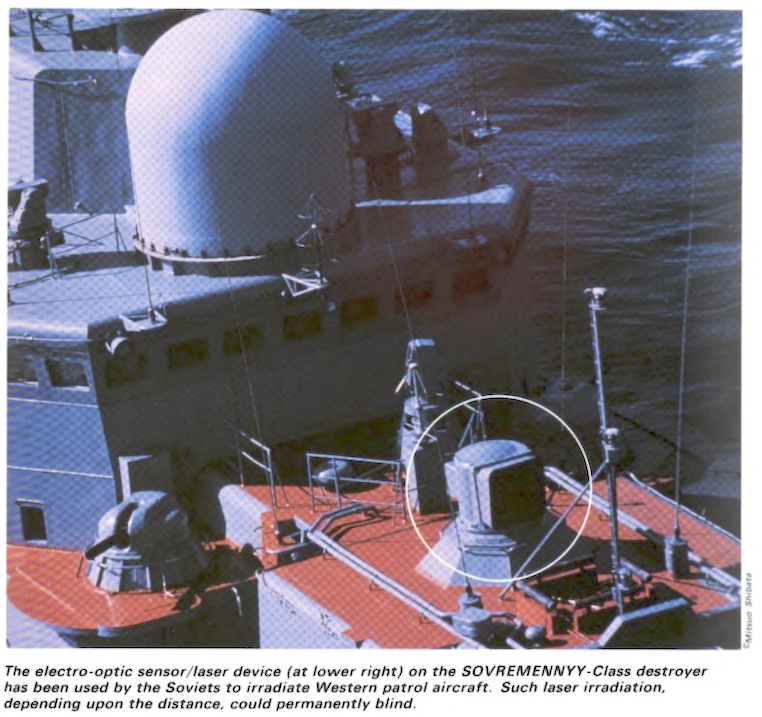
From the New York Times and the Los Angeles Times
US and Iran: UPDATED - Iranian naval ship shines laser on US helicopter says U.S.; Iran denies
A group of three U.S. ships — a destroyer, an amphibious assault ship, and a dry cargo ship — were transiting international waters in the Strait of Hormuz, according to a U.S. military statement. The Iranian naval vessel, said by one source to be a missile ship, came within 800 yards of the assault ship and scanned two of the U.S. ships with a spotlight.
The helicopter was flying alongside the deployment when the Iranian targeting laser was aimed at it, setting off the flares.
There was no report of injury to the helicopter pilots. A spokesperson for the U.S. Navy’s Fifth Fleet said “Illuminating helicopters with lasers at night is dangerous as it creates a navigational hazard that can impair vision and can be disorienting to pilots using night vision goggles.”

Marine Corps Sikorsky CH-53E Super Stallion
From Newsweek and CNN
UPDATED JULY 16 2017 - Iran claimed it did not point a laser at the helicopter. The Tasnim News Agency said “A top commander of Iran’s Navy denied reports that the country’s naval forces had pointed a laser at an airborne US Marine Corps helicopter in the Strait of Hormuz back in June. Commander of Iran's First Naval Zone Admiral Hossein Azad categorically denied reports of such incident.”
The report had no additional details, such as what could have set off the helicopter’s flares as claimed by the initial U.S. report.
From the Tasnim News Agency and the Tehran Times
US: Two brothers in South Texas charged with aiming laser at helicopter
The incident happened August 25 2016 in Mission, Texas. The pilot’s vision was temporarily impaired as the laser light lit up the cockpit. The pilot directed ground officers to a home, where Aaron Caceres, 27, and his brother Francisco Caceres, 24, confessed to the laser misuse.


Aaron (27) and Francisco (24) Caceres
They were charged with illumination of aircraft by intense light, a Class A misdemeanor.
From ValleyCentral.com and Chron.com
Iran: U.S. ship and helicopter targeted by laser on Iranian merchant ship
There were no reports of injuries or damage caused by the laser, so the Navy “believes it was not of industrial or military grade quality….” A Navy public affairs officer from the U.S. Naval Forces Central Command called the Iranian use of the laser as “unsafe” and “unprofessional.”
From CNN and Stars and Stripes. Thanks to Greg Makhov for bringing this to our attention. Note: The U.S. Navy in November 2014 deployed the first laser weapon sent into trials on an active duty warship, the USS Ponce. Six commercial welding lasers are merged into a single beam of 30 kilowatts, that can be used against targets including Iranian gunboats, according to SlashGear.
Australia: "Slight eye pain" for crew of helicopter targeted by teen
It is alleged the man targeted a Seahawk helicopter from 816 Squadron as it was returning to HMAS Albatross after a training flight about 10.30pm. The high-powered laser was pointed at the aircraft for around a minute from the car park of the man’s workplace at South Nowra.
The helicopter landed safely, with the four crew members on board treated for slight eye pain.
Police from the Shoalhaven Local Area Command interviewed the pilot and co-pilot, who provided an approximate location of the beam’s origin. Police searched the area and located the 19-year-old man.
A laser pointer was seized by police and the man was issued with a future court attendance notice and is due to appear in Nowra Local Court on November 19.
From the South Coast Register
Ukraine: Video shows Russian soldier aiming laser at recon plane
The propeller plane was patrolling the northern part of Crimea when it was fired upon during daylight hours.
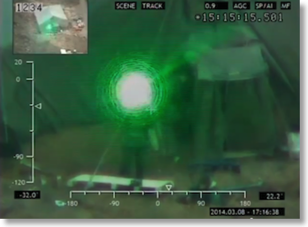
A still frame from the video, showing the soldier outside a tent
From The Aviationist
Egypt: Dozens of laser pointers aimed at helicopters during protest
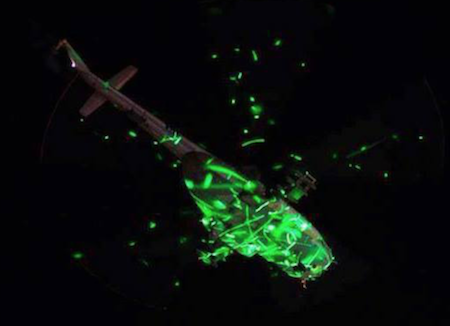
Complete coverage, including more photos and videos, is in this LaserPointerSafety.com story in the “Statistics, laws, all other news” section.
US: Camp Pendleton Marines ask public to stop lasing their noisy helicopters
Camp Pendleton’s Munn Field is used almost exclusively by helicopters, primarily on training missions. The chopper noise is “a backdrop to daily life in Fallbrook”, writes reporter Tom Pfingsten. He implied that perhaps someone annoyed by the noise is targeting the helicopters.
The air traffic control officer for Munn Field told Pfingsten that the lasers can potentially damage eyes and that pilots may not be able to see in the cockpit, especially when crews are wearing night vision goggles that bloom when hit by laser light.
Pfingsten wrote that “the Marines seem really worried about … losing one of their pilots to a random act of vandalism.” While the base files reports with the FAA and the Fallbrook sheriff, military police cannot be sent to find the laser source. So they are basically “asking nicely” that the public help stop whoever is lasing the military helicopters.
From the North County Times
US: UPDATED - 100-year sentence possible for Va. man after two laser incidents
- Two counts of interference with flight crew (20 years maximum penalty for each count)
- Two counts of aiming a laser pointer at an aircraft (5 years maximum penalty for each count)
- Two counts of assaulting, resisting or impeding federal officers (25 years maximum penalty for each count)
The Virginian-Pilot reported that Bruce aimed lasers at the jets “more than a dozen times” since December 2011. He was annoyed by the their noise. The two counts of assaulting federal officers may be related to Bruce calling the air station to threaten to shoot at the noisy aircraft.
According to a press release, “it is believed that the Eastern District of Virginia is the second jurisdiction to indict” using the new Federal law passed February 14 2012, making it a criminal offense to aim a laser pointer at or near an aircraft.
From the U.S. Attorney’s Office press release, PilotOnline.com, and WAVY.com
UPDATE July 31 2012: Bruce pleaded guilty to one count of interfering with the operation of an aircraft. The other five counts were dropped in exchange for the guilty plea. Bruce will be sentenced October 19 2012. He could receive up to 20 years in prison and a $250,000 fine. Pilots testified that they saw lasers at least 10 times from the area of Bruce’s house between December 29 2011 and June 5 2012. One of the pilots lased by Bruce reported that direct eye exposure was painful, distracted her during landing, and gave her a headache. A spokesperson for Oceana Naval Air Station said that, of 18 laser incidents in Virginia Beach since December 2011, 12 of the incidents were due to Bruce. There were 12 incidents total in 2011. From the Virginian-Pilot.
Switzerland: CHF 7,700 fine for aiming laser at Montreaux helicopters
Since the incident, “powerful” lasers have been outlawed in Switzerland, but pilots still report incidents. The Swiss emergency rescue team Rega says lasers have been pointed at their helicopters 16 times from January to October 2011.
From World Radio Switzerland. The original October 2010 story of the arrest and crew injuries is here.
US: DOD confirms eye injury to copter passenger; perhaps from Russian vessel Kapitan Man?
Coast Guard and Navy personnel boarded the vessel on April 7 but were unable to find any laser device, or evidence of a possible device. U.S. Navy Lt. Cmdr. Jack Daly was then examined by military laser eye injury experts, who found “there was a high probability that the minor burns on the lieutenant's right retina were caused by multiple laser exposures such as might result from a single glimpse at a repetitive pulsed laser.”
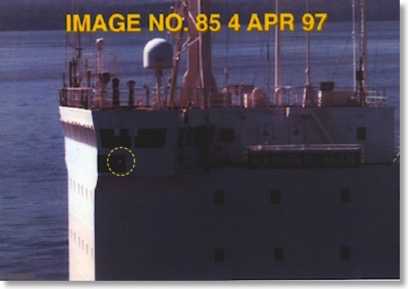
The American naval officer took this photo in the Strait of Juan de Fuca showing a red light on the M/V Kapitan Man. The light led some to suspect a laser. However, subsequent inspection did not find a laser, and in the location of the red light were “two deep red running lights … that met the guidelines established for sidelights.”
The U.S. Defense Department concluded that “[a]vailable evidence does not indicate…what the source of such an exposure might have been. Specifically, there is no physical evidence tying the eye injury of the American officer to a laser located on the Russian merchant vessel.”
The Strait of Juan de Fuca laser incident was also discussed in the August 2004 medical journal Archives of Ophthalmology. The article “Assessment of Alleged Retinal Laser Injuries” describes “Case 5” and concludes that “…[n]o evidence of laser injury was found in the years after the incident by 17 other ophthalmologists, including 5 neuro-ophthalmalogists and 8 retina specialists. A trial was held 5 years after the incident in which the retina specialist who made the initial diagnosis steadfastly maintained all the photographer’s [naval officer’s] symptoms were due to retinal laser injury. A jury ruled against the photographer’s claim for damages against the ship’s owner.… The patient had real complaints, but they were caused by preexisting autoimmune problems rather than by laser injury.”
The full text of the DOD press release, and the “Case 5” study is below (click the “Read More…” link). Additional information above is from a 2011 Washington Times story.
Scotland: Laser causes "considerable distraction" during sea rescue
A Royal Navy spokesperson said the lasing was “extremely reckless and irresponsible behaviour…. Had we been in the middle of a rescue, this person’s actions could have jeopardized our ability to continue.”
Strathclyde Police were notified; as yet no suspect has been identified.
From BBC News. Click the “Rescue” tag in the left hand column to find similar stories of disrupted rescue operations in the UK and elsewhere.
UK: North London teen gets 6 month jail sentence
According to the judge, “this was an extremely serious offence which could have ended in several fatalities” to those on board and on the ground.
From the Daily Express and Willesden & Brent Times
UK: 4 months for steady aiming at RAF Tornado jet

Four month sentence for Radu Moldovan
His lawyer said that Moldovan “wanted to see how powerful” the £4 green laser pen was. The laser beam was aimed at or near the aircraft multiple times. The local sheriff said “The consequences of a Tornado crashing at RAF Leuchars raises the most horrific possibilities of death and injury to the pilot, navigator and anyone passing underneath.”
From BBC News
US: NJ man arrested in helicopter incident
According to CBS 3, the pilot was “blinded” which caused “difficulty in flying the air craft.” Police on the ground located Villalobos, who admitted to flashing the helicopter. He “thought it had been a news helicopter.”
From CBS 3